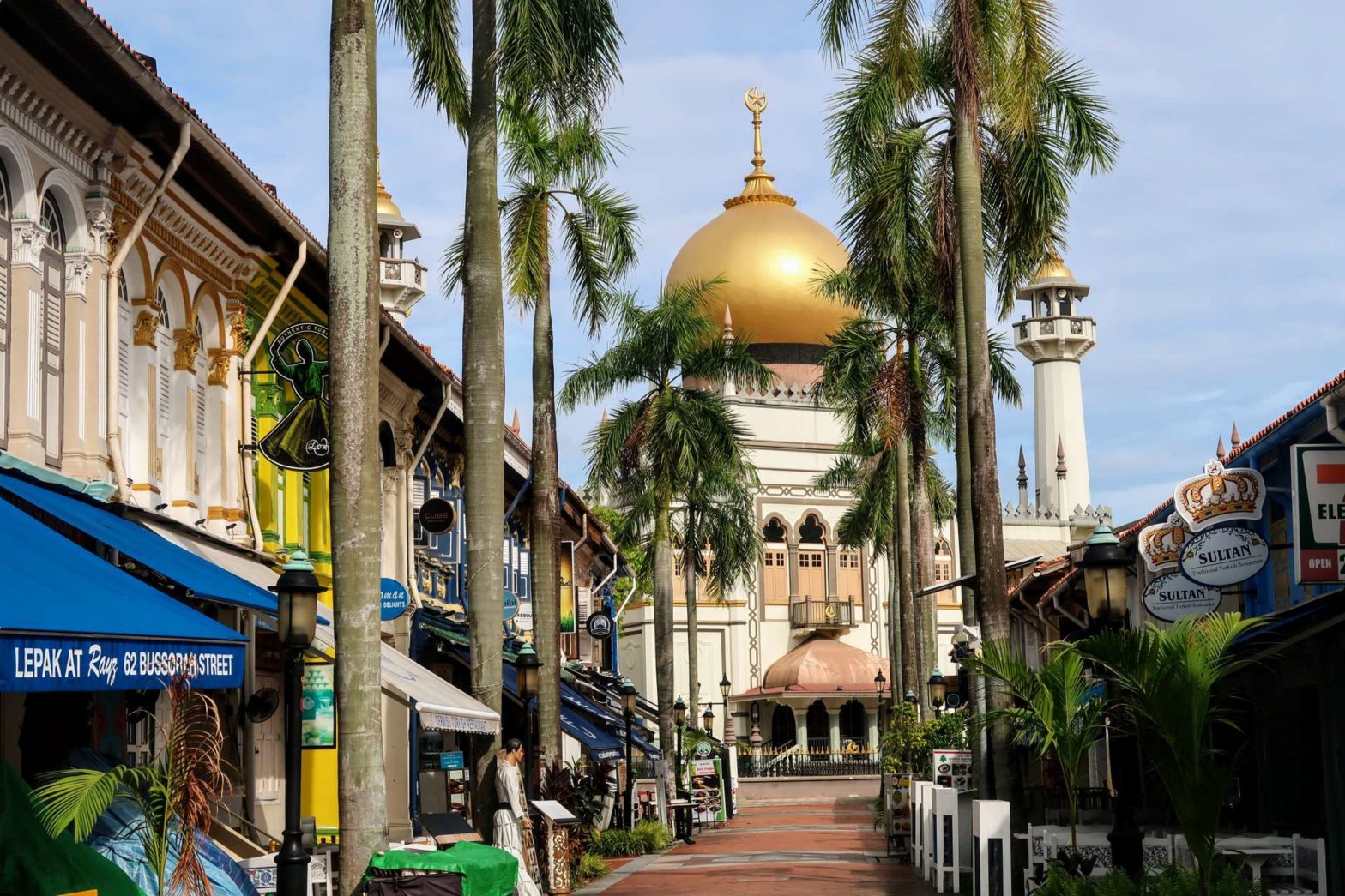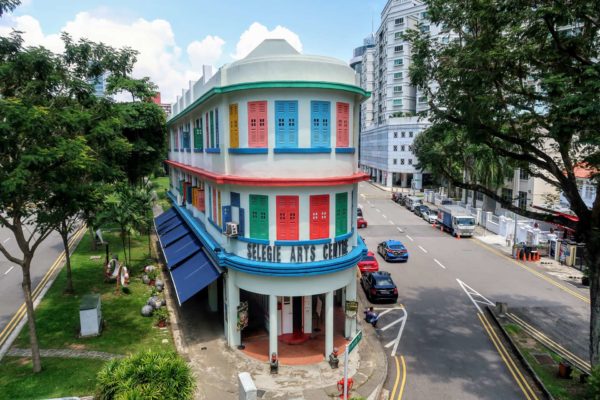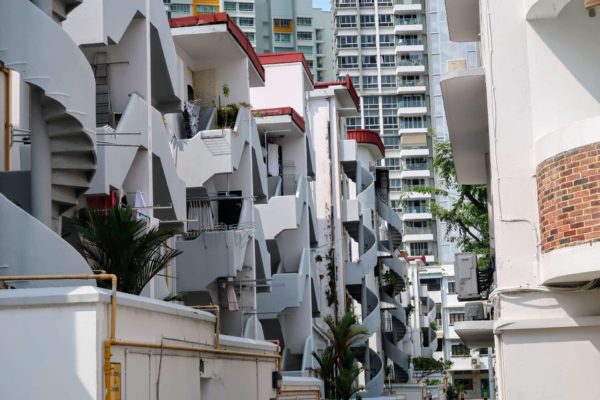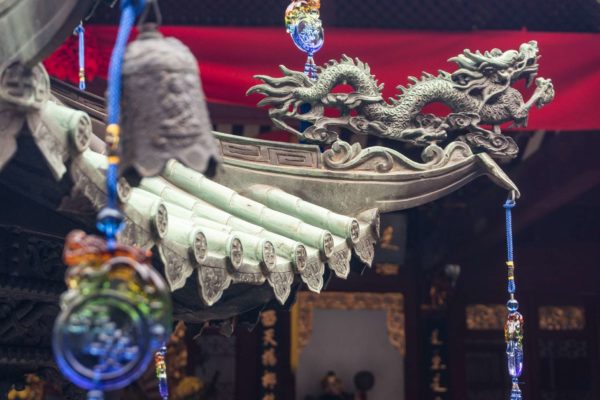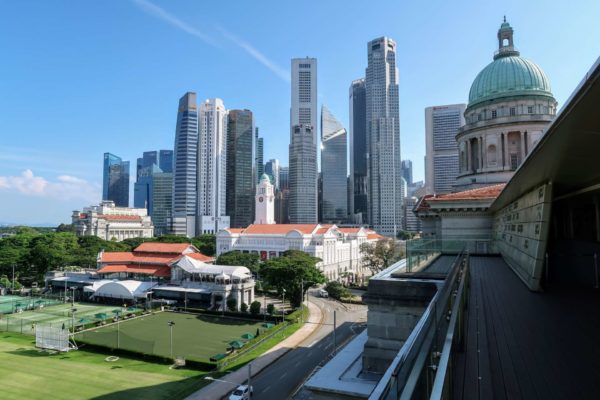By Vicky · Published Nov. 7th, 2021 · Updated Mar. 31st, 2023
When you buy through links highlighted with an asterisk (*) on this site, we may earn a small affiliate commission at no cost to you.
On this Kampong Glam walking trail, explore one of the coolest neighbourhoods in town, with culture, nightlife, delicious food and Malay heritage.
Page Contents:
How to get to Kampong Glam
Kampong Glam area is on the northeast side of the city centre. It’s a short walk from the nearest MRT, Bugis MRT station on the Green Central Line, or easy access from the many buses that travel along the surrounding main roads – Victoria Road, Beach Road or Rochor and Ophir Road.
Kampong Glam from Bugis MRT
To get to Kampong Glam from Bugis MRT, head for exit E. At the top of the escalator, turn right (NE) along Victoria Street. Continue for a few hundred metres, then turn right down Arab Street and start the Kampong Glam walking trail.
Kampong Glam Walking Tour Map
Get the route by downloading the .gpx or .kml file below. For navigation with Maps.me on your mobile phone, simply download the .kml file and open to add it to the Maps.me bookmarks.
Tips for Kampong Glam Walking Trail
- The Malay Heritage Museum is open 10 – 6 every day except closed on Mondays.
- To shorten the route, you can end at the Malay Heritage Museum.
- For an extension, head to Little India, a few minutes walk away.
- Early mornings are a great time to walk this trail in Kampong Glam because of the cool air.
- Evenings are another good time to walk this trail as Bali and Haji Street come alive, and coloured lights brighten up the mosque.
Attractions on the Kampong Glam Walking Trail
On this walking trail through Kampong Glam, you’ll see the main sites and attractions of Kampong Glam:
- Sultan Mosque
- Bussorah Street
- Arab Street
- Bali & Haji Lane
- Malay Heritage Centre
- Malabar Mosque
- Church of our Lady of Lourdes
This is a free, self-guided walking tour. If you prefer to join a guided tour of Kampong Glam, there are some great walking tours on Klook*.
When was Kampong Glam founded?
The area of Kampong Glam was assigned to Sultan Hussein and his family by Sir Stamford Raffles in 1819. Kampong Glam grew up as a port town, attracting traders from the many islands of Indonesia, Malaysia and elsewhere. In the two centuries since Kampong Glam was founded, land reclamation means this historic district is no longer on the edge of the ocean. Beach Road, on the southern edge of Kampong Glam, is now roughly 3 km from the ocean.
Directions: From Arab Street, head left (east) on North Bridge Road to admire the back of the Sultan Mosque.
As you stroll along North Bridge Road, you’ll see the back of the gold-domed Sultan Mosque reaching into the sky.
Apart from views of the mosque, you see that North Bridge Road is full of good-value local eateries. These sell mainly halal Indonesian and Indian-Muslim food, such as Nasi Padang and Murtabaks (glossary↓).
Directions: Head right (south) on Kandahar Street and right again through the obvious arch onto Muscat Street and to Sultan Mosque.
1. Sultan Mosque
Key Information: Open for self-guided visits 10AM-12PM, 2PM-4PM Sat-Thu. Fri closed. Follow dress code or get one of the robes available at the mosque counter on first come first serve basis, see the website.
Sultan Mosque, or Masjid Sultan, dominates the centre of Kampong Glam conservation area and is a highlight of this walking trail. This large mosque is very picturesque, and the most famous tourist attraction of Kampong Glam.
You can visit parts of the mosque on self guided tours, or peak into the mosque from the front just below the large golden dome. You’ll see the beautifully decorated inside, coloured mainly green with Arabic script flowing around the room.
Why was Sultan Mosque built?
In 1823, Sultan Hussein, who lived nearby in the Istana (palace) Kampong Glam, wanted a mosque he could easily visit. A simple mosque was built in the following years. Sultan Hussein’s grandson donated more land to the mosque, and eventually in 1924, a new mosque was built to replace the old one.
This building from 1924 forms the core part of the mosque you see today, and extensions in the same style were added much later in 1993. Interestingly, one of the mosque’s minarets was used as an observation post during the Second World War to watch for aircraft.
Who was Sultan Hussein?
Sultan Hussein originally ruled in Riau, the part of Indonesia opposite Singapore, west across the Malacca Straits. He was also involved in a successional dispute over the Sultanate of Johor. He won this dispute when Sir Stamford Raffles agreed to recognise him as the legitimate Sultan in return for allowing the British to set up a trading post in Singapore. They signed a treaty in 1819 which is seen as the founding of modern Singapore.
Sultan Hussein built his Istana, or palace, in Kampong Glam, which became a centre for Malay and Muslim communities.
Directions: From directly in front of Sultan Mosque, head south down Bussorah Street.
2. Bussorah Street
In front of Sultan Mosque lies Bussorah Street. This street is lined by beautifully restored, colourful shophouses and palm trees. It’s pedestrianised and full of lights, delicious smells and people during the evenings. In the early mornings it’s much quieter and you more easily admire the architecture and views of the mosque.
Bussorah Street is a great place to eat Middle Eastern food and there are many atmospheric Turkish restaurants. Restaurant touts will try and tempt you in. They serve good food in a nice setting, though prices can be higher than you might find elsewhere and it can be full of tourists.
As you walk down the road, remember to keep looking back to see the Mosque framed elegantly by the tall palm trees. Bussorah Street used to be called Sultan Road but was renamed in 1910 after Basra, a city in Southern Iraq. Other streets in the area also take their names from places in the Middle East.
Bussorah Street used to be an assembly and organisational point for pilgrims wanting to visit Mecca. Pious pilgrims gave advice to others and sold basic supplies, such as blankets, food and money belts, which pilgrims would need on their journeys. In 1975, with the development of commercial air travel, pilgrims ceased to flock to Bussorah Street.
Directions: When Bussorah Street meets Baghdad Street, at the end of the pedestrianised area, turn right until Arab Street and head right (north) or detour a while on the southern section of Arab Street.
3. Arab Street
Arab Street used to be a bustling centre of the materials and textiles trade in Singapore. Today it is quieter and has lost some of its atmosphere, though you can still see evidence of the importance of textiles to this street today. Many quaint little stalls sell rugs and fabric for saris and other clothing. It’s still the place to visit to get high-quality Persian rugs or prayer mats.
Several other shops are still run by descendants of early Arab traders to the region. They sell honey, dates, frankincense and myrrh, and other goods imported from the Middle East.
Arab Street got its name in 1822, after the grand Singapore town plan designated this area for the Arab community. Before this, it was called Jawa Koi (Java Street) after the origin of the inhabitants who lived here.
Directions: Continue up Arab Street until North Bridge Road and head left (west) before turning left (south) again down Bali Lane.
4. Bali and Haji Lanes
Bali and Haji Lanes are narrow, insta-worthy streets full of bold street art and walls covered with imaginative graffiti. Many of the artsy murals on the walls have a Mexican theme, and for some reason many of the eateries are also Mexican.
Bali and Haji Lanes really come alive in the evenings when bands sometimes play and people sit outside to drink beer/wine/cocktails and eat the mostly Mexican Food. Happy hour is every day and lasts until 8 pm at most places. You can get two glasses of wine for $16, or a pint of beer for $10.
Directions: Cut to Haji Lane from Bali Lane, passing through the Blu Jaz Cafe (a great place to visit in the evenings, website, Tripadvisor Reviews*). At the first intersection, turn right to see the most interesting part of Bali Lane.
Bali and Haji Lanes are surprisingly quiet in the mornings when the restaurants and bars aren’t open. This makes it a great time to take photos of the street art. However, in the evenings, bright lights enhance some of the artwork, so come back again then!
How did Bali and Haji Lanes get their names?
Bali Lane got its name from the origin of the population who used to live on this street. The inhabitants mainly came from Java, many of whom were from Bali. Bali Lane and the immediate surroundings were originally known as Kampong Bali, or Bali Village.
Haji Lane, on the other hand, was named after the title awarded to Muslim Pilgrims who had completed the hajj, or pilgrimage to Mecca. Males who complete the pilgrimage are known as Haji, while females are called Hajah. Since the Sultan Mosque and surrounding streets were centres for organizing travel to Mecca, many Malay and Muslim residents who had completed the Hajj lived on this street.
Directions: At the bottom of Haji Lane, head left (east) on Beach Road. Pass Arab Street and take the next left up Bussorah Street (north). At the intersection with Baghdad Street, turn right (east) and then left up Kandahar Street, which leads to the Malay Heritage Centre.
As you walk along Kandahar Street, watch out for the nice shophouses, some of the most decorative in Kampong Glam.
Opposite the Malay Heritage Centre, on the corner of Muscat and Kandahar Streets, we had a break for teh tarik and snacks at the cafe/restaurant with the red awning, Rumah Makan Minang (Website, TripAdvisor Reviews*). They serve halal Indonesian dishes and some smaller sweet treats. The cafe has a nice outdoor seating space with great views of Sultan Mosque, the food is tasty and the prices were not high.
5. Malay Heritage Centre
Key Information: Currently closed for revamp works. Normally open 10am-6pm every day except Mondays. Free for Citizens and Permanent Residents. $8 for adults otherwise, with reductions for students, seniors and children. Buy reduced-price tickets here*. Plan to spend an hour or two in the Malay Heritage Museum.
The Malay Heritage Centre (Website, Tripadvisor Reviews*) is located in Istana Kampong Glam, or the Sultan’s Palace, where the Malay Royalty lived. Sultan Hussein built the original wooden istana, or palace, in 1819. His son rebuilt it in 1840. In 2005, the government converted Istana Kampong Glam into the Malay Heritage Centre. This centre now houses a museum that focuses on the old Malay way of life and how it has changed as Singapore developed as a centre of trade. It also looks at culture such as theatre, opera, tv and music, and highlights famous Malay Singaporeans.
When you enter the museum, you’ll receive a Kampong Glam Heritage Trail booklet. It goes into a lot of detail about attractions and things to in Kampong Glam. It would take a long time to read through, perhaps after your visit or over a long lunch.
Explore Malay Heritage in Kampong Glam
- Visit the Malay Heritage Centre at Istana Kampong Glam.
- Make sure you see Sultan Mosque, it’s hard to miss!
- Walk to the old Malay Cemetery near Malabar Mosque.
- Try Malay food such as Nasi Pedang (glossary↓).
The Malay Museum talks a lot about Nusantara, but it doesn’t explain what this means. Nusantara is an old Javanese word that means ‘outer islands’. Within Indonesia, it’s used to mean all the Indonesian islands, though elsewhere it means any land with Malay-related culture. This includes Indonesia, Malaysia, Singapore, Papua New Guinea, Brunei, East Timor, the Philippines and elsewhere.
After the museum, you can quickly walk around the herb garden in the grounds. Some examples of the herbs are growing very well, while others seem to be entirely dead and now their labels stand in front of bare soil.
Malaysian Movie: Princess of Mount Ledang
The movie Princess of Mount Ledang, or Puturi Gunung Ledang, is a Malaysian movie that is worthwhile to learn a bit about the history of this part of the world. We happened to watch it the night before visiting the Malay Heritage Centre and were surprised to find many places and characters mentioned in the movie also in this museum. These include Majapahit and the Sultan of Melakka. The quality and acting in the movie isn’t always the best, and sometimes it was slightly boring, but it gave a feel of the region so I was glad to have watched it anyway. We found it on Netflix.
Moving on from the Heritage Centre
Directions: Exit to the south from the Malay Heritage Centre, onto Sultan Gate Road, through the gates opposite the main entrance to the istana museum building.
Shortcut: If you are feeling tired already, this is a good place to stop. You can return to Bugis MRT or catch a bus from nearby.
On your right, you’ll see the Gedung Kuning (Yellow Mansion), which was used by Sultan Hussein’s grandson. Yellow is considered a royal colour in Malay tradition. It’s now a newly opened (mid-2021) restaurant, Permata (Website, Tripadvisor Reviews*).
Directions: Continue along the road and take the first on the left (East) and then the first left again to walk up Aliwal Street.
Walking along Aliwal Street, you’ll see an art deco style white building on the right. This art deco building, built in 1938, formerly housed schools set up by the Chinese Hokkien community. It’s now the Aliwal Arts Centre. To the left you can see the Istana Kampong Glam and the Sultan Mosque behind it.
Directions: At the end of Aliwal Street you’ll hit the large Victoria Street. Across the road to the right, you should be able to see Malabar Mosque, which is the next stop.
6. Malabar Mosque
This mosque is a striking blue building, now on the corner at a busy road junction. Malabar Muslims are those from the Malabar Coast of southwest India. They built this Mosque between 1956 and 1963. Many of the Malabar Muslims migrated to Singapore in the nineteenth and early twentieth centuries.
Directions: From the mosque head north on Jalan Sultan (one of the oldest streets in Singapore) towards Rochor River. Turn left just before the bridge to stroll along the river.
On your left, you’ll see small gravestones of the Old Malay Cemetery in the grass and amongst the trees. These cemeteries date from roughly the 1820s and used to be surrounded by mangroves.
The river, on the right, is not that scenic but at least there are no cars. This river used to be a centre of sawmills and wood trade, processing wood brought in from Malaysia and Indonesia.
Directions: 400 metres along the river, you’ll see the final stop, a cute church, the other side of the large bus terminal which has many buses going to Malaysia. You have to approach it from Ophir Road, on the far side.
7. Church of Our Lady of Lourdes
The Church of Our Lady of Lourdes was built in 1886-1888 by the Indian Catholic Community. The beautiful inside is worth seeing if it’s open, where you can sit on the benches and enjoy the peace and tranquillity. This church is the final stop on the Kampong Glam walking trail.
Directions: There’s a bus station at the front of the church, or Bugis MRT station is only a few hundred metres away. Cross over Ophir Road and Queen Street, then cut through the green field surrounded by cars and trees to Bugis MRT station.
Glossary of Useful Language Terms in Kampong Glam
- Haj – pilgimage to Mecca
- Haji/Hajah – a man/woman who has done the haj
- Istana – palace
- Jalan (abbreviated Jln) – road, or direction
- Kampong – village
- Nusantara – countries with Malay culture
- Pondok – communal lodging house
- Shophouse – narrow but deep terraced house typical of Singpoarean streets that have not been redeveloped
- Temmongong – prime minister of the sultans
- Wayang – theatre
- Nasi – rice
- Nasi Padang – the classic Sumatran meal of rice with other dishes, mainly cooked with coconut milk.
- Rendang – typical Indonesian beef stew
- Mee – noodles
- Kuih – cake
- Satay – kebabs
- Ketupat – rice dumplings in coconut leaves
- Biryani – an Indian rice dish
- Murtabaks – fried bread stuff with meat
Nearby Kampong Glam
Just southwest of Kampong Glam, across Ophir Road and not far from Bugis MRT, an imposing brass-coloured skyscraper immediately captures your notice. This is Parkview Square. Although built in 1999, it was constructed in an art-deco style. Housed in Parkview Square is the iconic Atlas Bar (Website, Tripadvisor Reviews*). This is an opulent bar open 8 am – 1 am, also serving a delicious-looking afternoon tea.
Kampong Glam Walking Trail by Night
Kampong Glam area is a worthwhile place to visit in the evening. The street art of Bali and Haji Lanes comes alive and these lanes are full of people and often live bands. The evening means it’s cooler to walk and you enjoy an evening meal. Happy Hour at Bali/Haji Lanes normally ends at 8 pm in most restaurants.
Lights also shine onto Sultan Mosque and Bussorah Street in the evening, making for nice photos.
Guidebooks to Explore more of Singapore
To discover more heritage in Singapore, check out the nearby Little India Walking Tour, explore hip Joo Chiat, check out historic Chinatown or buzzing Marina Bay. For more neighbourhood walks and hikes, check out our Singapore Guide.
FAQS: Kampong Glam Walking Trail
Kampong Glam, or sometimes Kampong Gelam, means village of Gelam trees. Kampong is the Malay word for village, and Gelam is a type of native tree, the Cajeput tree. Cajeput oil is used for medicinal purposes, including in Tiger Balm, and the wood of the Gelam tree can be used to make boats.
There is a competing, and perhaps complementary theory on what Kapong Glam means. The Orang Gelam people lived nearby and perhaps the area was named after the original inhabitants.
Kampong Glam is known for Malay and Muslim culture which can be explored at the Malay Heritage Centre. The most famous landmark is the beautiful Sultan Mosque. Kampong Glam is also known for its Middle Eastern and Indonesian food, and its nightlife and bright street art on the narrow Baji and Haji Lanes.
1. Be awed by the beautiful Sultan Mosque
2. Eat Middle Eastern food on Bussorah Street
3. Shop for carpets and materials on Arab Street
4. Take photos on Bali & Haji Lane
5. Learn about the culture at the Malay Heritage Centre
6. Admire the stunning Malabar Mosque
7. See the historic Church of Our Lady of Lourdes

